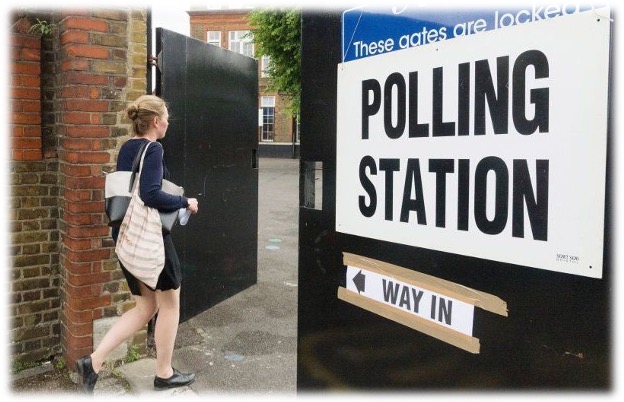This is Blog No 23
Three weeks to go – and the pace is hotting up.
I’ve received election addresses through the door, narrowly avoided being personally canvassed and a good friend who is standing in a neighbouring town writes me an impassioned personal email to persuade me that voting ‘independent’ is the right thing to do because local government should not be party political.

I salute all candidates. Our democracy needs well-motivated public servants able to devote their time and talents to representing their fellow-citizens. It can be a thoroughly thankless task, and in many ways, governing our local authorities is what in Macbeth, Shakespeare called a ‘poisoned chalice’.
Well, it might not be quite that bad, but for many Councils, the coming years promise a continuing financial squeeze as nationwide commitments to wicked issues like adult social care and children’s services require deep cuts to other services from pools to potholes.
And not just in England. I have been reading the Scottish Local government Benchmarking Overview Report for 2021-2022. Here is an interesting extract:
‘Expenditure within social care and education continues to be sustained and enhanced, increasing since 2010/11 by 25% and 19% respectively, while relative reductions continue in non-statutory services in order to provide balance to statutory and ringfenced commitments elsewhere. Since 2010/11, this has included: 24% reduction in culture and leisure spending; 28% reduction in planning spending; 25% reduction in corporate support service spending; 16% reduction in roads spending; 27% reduction in trading standards and environmental health spending; and 13% reduction in environmental services spending…’
The numbers may be different in England and in Wales, and of course every single Council has a unique set of issues. But the overall pattern is the same. Our centralised system is great at demanding from local government efficiencies and sacrifices which it is seldom willing to suffer itself.
Predictably, those who win their seats may face an avalanche of tough choices. They may have to vote for the lesser of several evils. They may need to run the gauntlet of organised campaign groups defending much needed services that the Council can’t now afford.
Less civic pride; more civic panic.
Yet all this is without factoring in a raft of net zero policies designed to change behaviour in ways the electorate does not necessarily support!
What will the conscientious Councillor do?
To my mind, one answer is to invest heavily in public engagement and consultation, both on an individual and a Council-wide basis. Here’s why:
- It’s critical to carry the public with us. The harder the decision and the greater the impact - the more we need to invest in sharing the problem; explain the constraints; illustrate the options; invite input. Above all be honest. one thing that’s worse than disruptive change is imposed disruptive change. Being able to say truthfully ‘we discussed this with you’ is better than ‘We’re doing it regardless...’
- Councillors always need reminding that they have a weak mandate. Turnout at local elections is low, and it is unwise to assume that votes at the ballot box necessarily reflect the wider community’s priorities and preferences. Elected members mostly recognise this. A 2022 survey by the Electoral Reform Society found that 65% of Councillors agreed with the statement Citizens should be more involved in making decisions about their local area. But who do you listen to? My ‘independent’ friend may here have a point. Listening to the wider electorate may be better than following the agreed policy of a party group. If in doubt- engage!
- There ARE ways to reduce the impact of service changes. Salami slicing seldom works but re-engineering public services can improve targeting and reduce inefficiencies. Just don’t rely exclusively on officers who are naturally biased towards existing structures and mechanisms. Instead, push hard for co- production and the direct involvement of service users. That is great for developing options but needs wider consultation before being adopted. That last element is easily omitted in the enthusiasm of having redesigned something but is an important safeguard in case the co-produced redesign causes more problems than it solves.
Two things stand on the way of adopting a more consultative culture.
One is the reluctance of a traditional type of local government officer who prefers not to have his or her advice complicated by an overlay of stakeholder views. Hopefully this is a diminishing problem as the benefits of public engagement become increasingly obvious.
The other is the uncertainty of Councillors themselves, many of whom have heard vaguely about legal challenges to consultations undertaken by public bodies, who struggle to tell the difference between engagement and consultation or what they can do as individuals and what needs to be done by the Council itself.
Not everyone needs to be able to tell the difference between a Citizens jury and a Citizen’s Assembly, but they DO need to know what credibility to afford to various forms of public dialogue.
As we wish candidates of all parties (and none) well, let’s help them absorb best practice in the critical arts of consultation and in the growing opportunities to deploy them.
See Rhion's Speeches, Talks and Presentations.
For More like this - free of charge: SUBSCRIBE now
Leave a Comment
I hope you enjoyed this post. If you would like to, please leave a comment below.